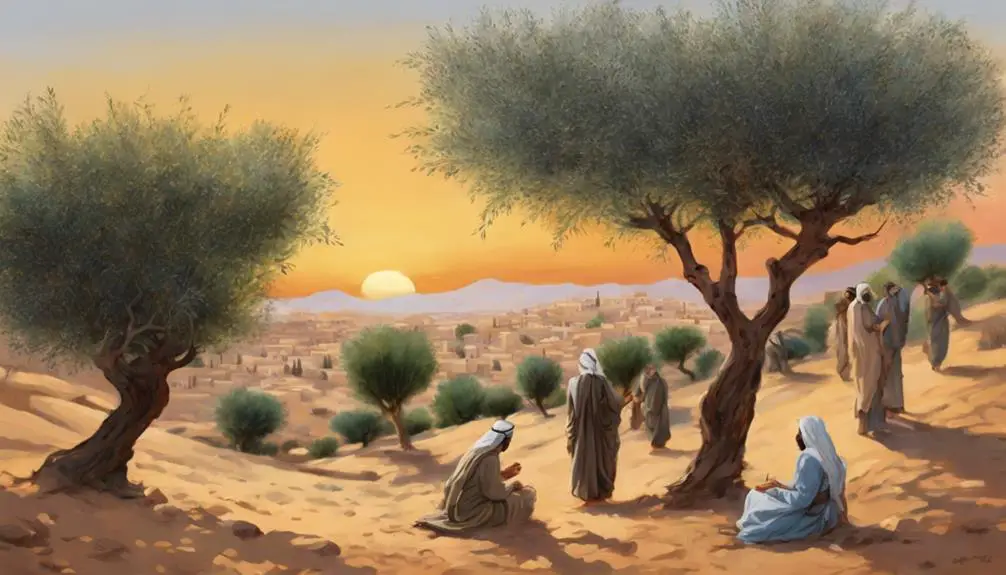Immerse yourself in the intriguing symbolism of the south wind in the Bible, where every whisper and gust holds a deeper meaning.

The South Wind in the Bible
Just as a gentle south wind signals a change in weather, its mention in the Bible often heralds a deeper, symbolic transformation.
You'll find that the south wind isn't merely a meteorological term but carries significant spiritual and cultural implications throughout the scriptures. It's woven into narratives and prophecies, each instance ripe for exploration.
Scholars have poured over these references, interpreting them in ways that illuminate our understanding of ancient texts and their relevance today. By examining the symbolism and significance of the south wind, you'll uncover layers of meaning that might just change how you view the biblical world.
Let's embark on this journey together, shall we?
Key Takeaways
- The South Wind symbolizes change, divine intervention, and spiritual transformation in biblical narratives.
- It reflects both physical and metaphorical shifts, influencing agricultural cycles and divine favor.
- Biblical references associate the South Wind with warmth, storms, and divine control, highlighting its dual nature.
- Scholars interpret the South Wind as a metaphor for emotional or spiritual states, bridging ancient texts with contemporary faith.
Symbolism and Significance

In the biblical context, the South Wind carries a profound symbolism, often signifying change or transition, guiding you through its multifaceted significance with clarity and reverence. This directional wind, more than a mere meteorological phenomenon, serves as a rich vessel for climatic metaphors, deeply intertwined with the geographical influences of the biblical lands.
You'll find that the South Wind, emanating from the desert, isn't merely a harbinger of warmth but also a metaphorical representation of the divine intervention and the spiritual transformations that accompany life's seasons. Its warm embrace can symbolize comfort and the providence of growth, yet its intensity warns of the trials and purifications necessary for profound personal change. This duality mirrors the geographical contrasts within the biblical landscapes themselves, where the lush fertility of one region can abruptly meet the stark austerity of another.
The South Wind's significance is further amplified when you consider the climatic metaphors prevalent in biblical teachings. It's as if the very air you breathe while wandering through these ancient texts carries whispers of wisdom, urging you to reflect on the transient nature of life and the constant presence of divine guidance. The geographical influences of the biblical narratives enrich these metaphors, grounding spiritual lessons in the tangible and familiar.
Thus, the South Wind, with its complex interplay of climatic and geographical symbolism, invites you to delve deeper into the spiritual messages woven throughout the biblical narrative, offering insights that resonate with both the heart and the mind.
Biblical References and Contexts

Exploring the specific instances where the South Wind appears in biblical scripture offers a deeper understanding of its symbolic resonance and spiritual implications. You'll find that the South Wind, with its geographic origins and weather patterns, plays a meaningful role in the narratives and teachings of the Bible.
The geographic origins of the South Wind are significant, often associated with the desert or arid regions to the south of Israel. This origin speaks volumes about the conditions and experiences of those who felt its breeze. Weather patterns associated with the South Wind, such as warmth and sometimes storminess, add layers of meaning to its biblical appearances.
To emphasize the importance of the South Wind's appearances and contexts, consider the following table:
Reference |
Context |
|---|---|
Job 37:17 |
Highlights the South Wind's warmth, contrasting with the north's cold. |
Luke 12:55 |
Jesus uses the South Wind to teach about interpreting signs. |
Acts 27:13 |
Describes a gentle South Wind before a storm, symbolizing false hope. |
Psalm 78:26 |
God commands the South Wind, showing divine control over nature. |
Song of Solomon 4:16 |
Invokes the South Wind to spread the fragrance of a garden, symbolizing love and growth. |
These references, analyzed in a scholarly and reverent manner, reveal the South Wind's multifaceted role in biblical texts. You'll notice it's not merely a meteorological phenomenon but a symbol woven into the fabric of biblical narratives, reflecting divine intervention, emotional states, and the natural order's influence on human life.
Interpretations by Scholars

Scholars have delved into the significance of the South Wind in biblical texts, uncovering layers of meaning that speak to both the ancient and modern believer. Through rigorous historical accuracy and linguistic analysis, they've provided insights that enrich our understanding of scripture. Here are four key interpretations they offer:
- Symbol of Divine Intervention: Some scholars argue that the South Wind often symbolizes divine intervention or change. Its sudden appearance in biblical narratives is seen as a metaphor for God's power to swiftly alter circumstances in favor of His people.
- Indicator of Seasonal Change: Linguistic analysis reveals that references to the South Wind could indicate seasonal transitions and, by extension, spiritual renewals or shifts in narrative direction. This dual interpretation underscores the text's layered meanings and its relevance across different contexts.
- Reflection of Historical Climate: Experts in historical accuracy point out that understanding the climatic conditions during biblical times adds depth to our interpretation of the South Wind. It wasn't merely a literary device but a real-world element that affected daily life, agriculture, and travel, making its mention in scripture a reflection of historical realism.
- Metaphor for Emotional or Spiritual State: Lastly, some interpretations focus on the South Wind as a metaphor for the emotional or spiritual state of characters or communities within the Bible. Its warmth and gentleness are often contrasted with harsher conditions, symbolizing comfort, hope, or the presence of God amidst trials.
Through these scholarly interpretations, you gain a multifaceted understanding of the South Wind's significance in biblical literature, bridging ancient texts and contemporary faith.
Cultural and Spiritual Implications

Delving into the cultural and spiritual implications of the South Wind reveals its profound impact on the collective psyche and religious practices of ancient communities. Weather patterns, particularly those as distinctive as the South Wind, served not just as meteorological phenomena but as carriers of deeper, spiritual meanings. This understanding was deeply rooted in the geographical influences that shaped the lives of these early societies.
You'll find that in regions where the Bible's stories unfold, the South Wind often signified change—a physical and metaphorical shift. Its arrival could herald the transition from one season to another, influencing agricultural cycles, and by extension, the economic stability and spiritual well-being of a community. This connection between the heavens and the earth, the divine and the mundane, was central to their worldview.
Moreover, the South Wind's characteristics were imbued with spiritual significance. Its warmth could symbolize God's favor, bringing life and prosperity, while its potential for destruction in the form of storms might represent divine displeasure or testing. These interpretations were integral to the fabric of these ancient societies, influencing rituals, prayers, and even the architecture designed to withstand or embrace these weather patterns.
In essence, the South Wind was more than a weather phenomenon; it was a conduit through which divine messages were perceived and interpreted. Its impact on cultural and spiritual practices highlights the intricate relationship between the physical environment and the spiritual insights of the people who lived under its influence. Analyzing these connections offers a richer understanding of their faith and resilience in facing the challenges of their world.
The South Wind in Prophecy

In biblical prophecy, the South Wind emerges as a symbol with multifaceted interpretations, reflecting the complexities of divine communication and human understanding. This phenomenon intertwines weather patterns and geographical influence, offering you a profound insight into the intricate ways the Bible conveys its messages.
Here's how the South Wind in prophecy can be understood:
- Indicator of Change: The South Wind often symbolizes impending change. Its sudden appearance in scripture can signify a divine intervention or a shift in the narrative, urging you to consider the transient nature of life and the constant presence of divine oversight.
- Symbol of Blessing or Judgment: Depending on the context, the South Wind can either bring about blessings, such as rain in a drought-stricken land, or judgment in the form of scorching heat. This duality encourages you to reflect on the consequences of your actions and the inherent justice in divine retribution.
- Metaphor for Spiritual Awakening: The gentle, warming aspects of the South Wind can symbolize a spiritual awakening or renewal. It invites you to open your heart to the transformative power of faith and the comfort it provides in times of distress.
- Reflection of God's Sovereignty: The control over weather patterns, including the direction and nature of the wind, underscores God's sovereignty over creation. The South Wind, therefore, reminds you of the omnipotence and omnipresence of the divine, guiding you to trust in God's plan for your life.
Analyzing the South Wind in prophecy thus offers a profound understanding of biblical teachings, emphasizing the depth of God's communication with humanity.
Frequently Asked Questions
How Does the South Wind Compare to the Other Directional Winds Mentioned in the Bible in Terms of Its Frequency and the Nature of Its Mention?
You're exploring how frequently the south wind appears compared to other winds and the nature of its mentions. With a focus on South Wind symbolism and geographic implications, you'll find it's less common but carries significant meaning.
Its occurrences often symbolize change or convey geographic realities of the region. This analysis reveals a deeper, scholarly appreciation for how directional winds, especially the south wind, are woven into narratives with reverence and purpose.
Are There Specific Prayers, Rituals, or Practices in Biblical Times That Were Performed in Response to the South Wind?
You're delving into the heart of ancient traditions, like a scholar uncovering hidden scrolls. In your search, you'll find that specific prayers, rituals, or practices in response to the south wind aren't directly documented.
This aspect of wind symbolism, particularly cultural rituals linked to it, remains somewhat mystical. Your journey isn't just about the wind itself but understanding how societies have revered and responded to nature's whispers throughout time.
How Have Modern Technological Advancements Altered the Way We Understand or Relate to Biblical References to the South Wind?
Modern technology has reshaped your understanding of ancient texts, including references like the south wind. Through climate adaptation strategies, you're able to see how these seemingly mystical elements had practical impacts on daily life and beliefs.
Technological interpretation tools allow a deeper dive into the context and meaning, enhancing your appreciation for these references. This blend of science and faith offers a nuanced perspective, enriching your connection to these ancient narratives.
In What Ways Has the Depiction of the South Wind in the Bible Influenced Contemporary Art, Music, or Literature Outside of Religious Contexts?
You'll find the South Wind whispering through modern art, its gentle gusts carrying cultural metaphors beyond sacred texts. This breeze, once described in ancient scriptures, now breathes life into contemporary art, music, and literature, embodying artistic symbolism that transcends religious confines.
It's fascinating how this biblical element has been woven into the fabric of today's creative expressions, serving as a bridge between the sacred and the secular, enriching our cultural landscape with its timeless presence.
What Are the Scientific Explanations or Phenomena Associated With the South Wind During the Biblical Era, and How Do They Compare With Today's Understanding?
You're diving into how wind patterns and climate change have evolved from the biblical era to today. Scientifically, the south wind's effects were once seen as mysterious forces.
Now, with advanced meteorology, you understand these patterns in terms of atmospheric dynamics and global climate systems. Despite these advancements, it's fascinating how ancient observations still hold relevance, illustrating the enduring interplay between nature's forces and human perception across millennia.
Conclusion
So, after dissecting the ethereal whispers of the South Wind through the labyrinth of biblical narratives, what've we unearthed? Essentially, scholars, with their noses buried in ancient texts, argue it's not just a breeze but a celestial megaphone.
It's as if the heavens decided subtlety was passé and opted for meteorological memos instead. Through the cultural gusts and divine drafts, we've seen how a simple zephyr can carry the weight of prophecy, wisdom, and an occasional pollen allergy.
Truly, the South Wind isn't just blowing air; it's whispering the secrets of the divine, cloaked in the mundane guise of weather.



Sign up